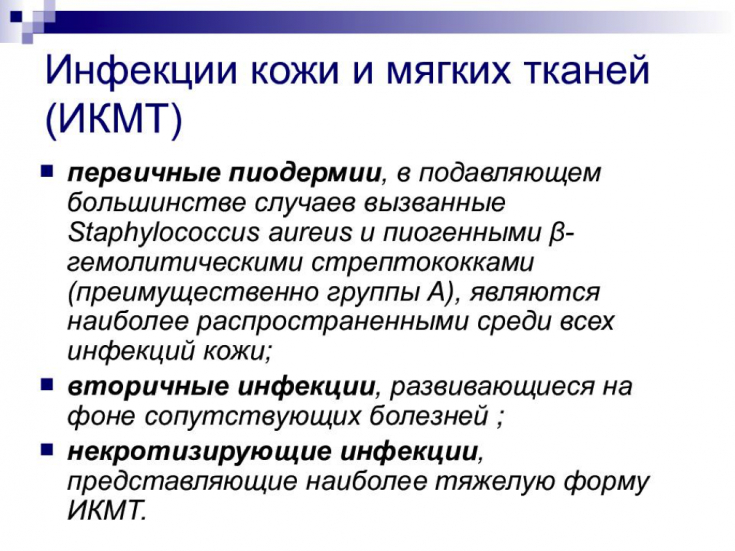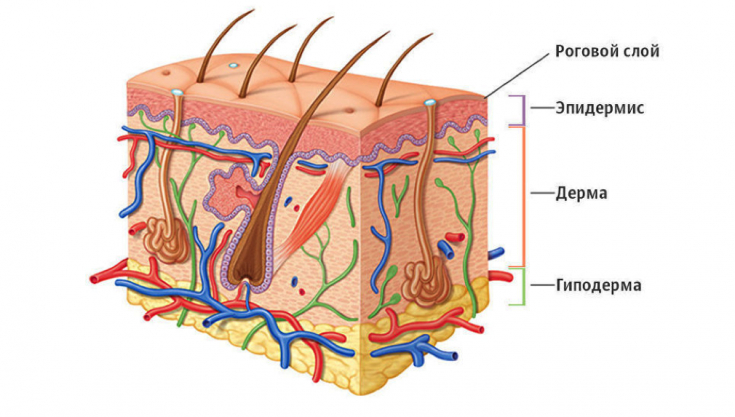The treatment of skin and soft tissue infections is a serious problem of modern medicine, given the global increase in resistance of gram-positive flora to traditional antibiotics, in particular methicillin-resistant strains of staphylococci, and stratification of the severity of skin and soft tissue infections is an important component in choosing treatment tactics.
Find out in the article on estet-portal.com
- approaches to the classification of skin and soft tissue infections
- prescribing antibiotics for skin and soft tissue infections
- surgical treatment strategy skin and soft tissue infections
Approaches to the classification of skin and soft tissue infections
types of infections of skin and soft tissues belong to typical phlegmons / erysipelas without purulent foci; to moderate infections ─ typical cellulitis / erysipelas with systemic signs of infection; severe forms of skin infection ─ ineffectiveness of oral antibiotics, systemic signs of infection, immunosuppression or clinical signs of deep tissue damage (skin detachment and necrosis , hypotension and signs of organ dysfunction).
Follow us on Instagram!
Treatment of skin and soft tissue infections is achieved with a combination of surgery and antimicrobial therapy. For example, for the treatment of subcutaneous abscesses, first of all, surgical treatment (opening and drainage) is used, and only for patients who do not respond to the initial interventions, additionally prescribe antibiotic therapy.
Prescribing antibiotics for skin and soft tissue infections
disease spread or abscesses in areas difficult to drain, with rapid progression of infection, signs of systemic disease, severe comorbidities or immunosuppression. The leading component of empirical choice antibiotic depends on the clinical manifestations of skin and soft tissue infections. In most cases where Gram-positive flora is the likely cause of skin infections and MRSA is not suspected, penicillins, cephalosporins, clindamycin, or trimoxazole are used.
Where the infection is polymicrobial in nature (infections in the immediate vicinity of the genital tract, rectum, bite wounds, etc.),antibiotic treatment should cover a wide range of pathogens.
Under such conditions, antibacterial therapy may include beta-lactam antibiotics protected by inhibitors, drugs with increased activity against gram-positive strains, such as glycopeptides, carbapenems, oxazolidinones, III-IV generation fluoroquinolones and new drugs (tigecycline, ceftaroline, etc.), combined with proper wound care and early surgical intervention, which occupies a leading place in the treatment of skin and soft tissue infections.
Ptosis of the upper eyelid: diagnosis and treatment AF Cardona et al. proved that infections of the skin and soft tissues are an important cause of morbidity and mortality among hospitalized patients and
become a serious challenge for clinicians. Although uncomplicated forms of ICMT are successfully treated on an outpatient basis, severe forms of infection that spread to the subcutaneous tissue, fascia or muscles require complex multi-vector treatment. Early diagnosis, selection of appropriate antimicrobials and timely surgical intervention are the keys to successful treatment.

Postoperative wound infections are an important component of skin and soft tissue infections. Gram-positive organisms, such as Staphylococcus aureus and Streptococcus pyogenes,
are the dominant organisms found early in the infection process, while Gram-negative organisms appear in chronic wounds.
What determines the cost of breast augmentation

Methicillin-resistant Staphylococcus aureus (MRSA) is a potential source for possible generalization of the infection, requiring aggressive antibiotic therapy and surgical treatment. tedizolid has been successfully used in the treatment of severe
MRSA. Surgical strategy for the treatment of skin and soft tissue infections For purulent infections of the skin and soft tissues, the treatment strategy for milder forms
is to open and drain; for moderate disease with systemic signs of infection, in addition to the above,add oral antibiotics
, for severe cases of infection, including failure after opening and draining with the addition of oral antibiotics, or, ifpresence systemic signs of infection (temperature > 38 ° C, tachycardia > 90 beats / min, tachypnea > 24 / min, changes in blood counts with a shift to the left) perform repeated surgical interventions, and also switch to parenteral administration of antibiotics. How effective is the use of compression stockings?
Treatmentof surgical infection of the skin and soft tissues focuses on surgical control of the sourceof the infection and antimicrobial therapy, taking into account the patient's individual risk factors and multidrug-resistant bacterial strains.
More useful information on ourYouTube
-channel






Add a comment